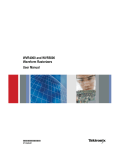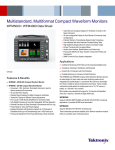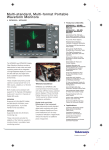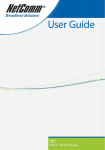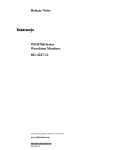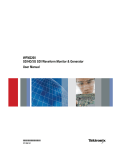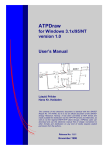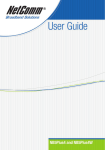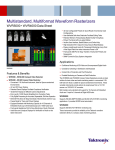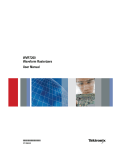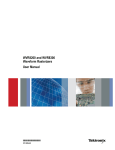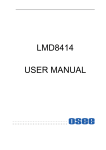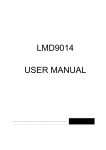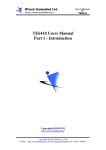Download WFM4000 and WFM5000 Waveform Monitors User Manual
Transcript
x WFM4000 and WFM5000 Waveform Monitors ZZZ User Manual *P077243802* 077-2438-02 xx WFM4000 and WFM5000 Waveform Monitors ZZZ User Manual www.tektronix.com 077-2438-02 Copyright © Tektronix. All rights reserved. Licensed software products are owned by Tektronix or its subsidiaries or suppliers, and are protected by national copyright laws and international treaty provisions. Tektronix products are covered by U.S. and foreign patents, issued and pending. Information in this publication supersedes that in all previously published material. Specifications and price change privileges reserved. TEKTRONIX and TEK are registered trademarks of Tektronix, Inc. Contacting Tektronix Tektronix, Inc. 14200 SW Karl Braun Drive P.O. Box 500 Beaverton, OR 97077 USA For product information, sales, service, and technical support: In North America, call 1-800-833-9200. Worldwide, visit www.tektronix.com to find contacts in your area. Warranty Tektronix warrants that this product will be free from defects in materials and workmanship for a period of one (1) year from the date of shipment. If any such product proves defective during this warranty period, Tektronix, at its option, either will repair the defective product without charge for parts and labor, or will provide a replacement in exchange for the defective product. Parts, modules and replacement products used by Tektronix for warranty work may be new or reconditioned to like new performance. All replaced parts, modules and products become the property of Tektronix. In order to obtain service under this warranty, Customer must notify Tektronix of the defect before the expiration of the warranty period and make suitable arrangements for the performance of service. Customer shall be responsible for packaging and shipping the defective product to the service center designated by Tektronix, with shipping charges prepaid. Tektronix shall pay for the return of the product to Customer if the shipment is to a location within the country in which the Tektronix service center is located. Customer shall be responsible for paying all shipping charges, duties, taxes, and any other charges for products returned to any other locations. This warranty shall not apply to any defect, failure or damage caused by improper use or improper or inadequate maintenance and care. Tektronix shall not be obligated to furnish service under this warranty a) to repair damage resulting from attempts by personnel other than Tektronix representatives to install, repair or service the product; b) to repair damage resulting from improper use or connection to incompatible equipment; c) to repair any damage or malfunction caused by the use of non-Tektronix supplies; or d) to service a product that has been modified or integrated with other products when the effect of such modification or integration increases the time or difficulty of servicing the product. THIS WARRANTY IS GIVEN BY TEKTRONIX WITH RESPECT TO THE PRODUCT IN LIEU OF ANY OTHER WARRANTIES, EXPRESS OR IMPLIED. TEKTRONIX AND ITS VENDORS DISCLAIM ANY IMPLIED WARRANTIES OF MERCHANTABILITY OR FITNESS FOR A PARTICULAR PURPOSE. TEKTRONIX’ RESPONSIBILITY TO REPAIR OR REPLACE DEFECTIVE PRODUCTS IS THE SOLE AND EXCLUSIVE REMEDY PROVIDED TO THE CUSTOMER FOR BREACH OF THIS WARRANTY. TEKTRONIX AND ITS VENDORS WILL NOT BE LIABLE FOR ANY INDIRECT, SPECIAL, INCIDENTAL, OR CONSEQUENTIAL DAMAGES IRRESPECTIVE OF WHETHER TEKTRONIX OR THE VENDOR HAS ADVANCE NOTICE OF THE POSSIBILITY OF SUCH DAMAGES. [W2 – 15AUG04] Table of Contents Table of Contents General Safety Summary . .. . .. . .. . .. . .. . .. . .. . .. . .. . .. . .. . .. . .. . .. . .. . .. . .. . .. . .. . .. . .. . .. . .. . .. . .. . .. . .. . .. . .. . .. . .. . .. . .. . .. . .. . . . . Environmental Considerations . . .. . .. . .. . .. . .. . .. . .. . .. . .. . .. . .. . .. . .. . .. . .. . .. . .. . .. . .. . .. . .. . .. . .. . .. . .. . .. . .. . .. . .. . .. . .. . .. . .. . .. . Preface .. . .. . .. . .. . .. . .. . .. . .. . .. . .. . .. . .. . .. . .. . .. . .. . .. . .. . .. . .. . .. . .. . .. . .. . .. . .. . .. . .. . .. . .. . .. . .. . .. . .. . .. . .. . .. . .. . .. . .. . .. . .. . .. . Key Features .. . .. . .. . .. . .. . .. . .. . .. . .. . .. . .. . .. . .. . .. . .. . .. . .. . .. . .. . .. . .. . .. . .. . .. . .. . .. . .. . .. . .. . .. . .. . .. . .. . .. . .. . .. . .. . .. . .. . Instrument Options .. . .. . .. . .. . .. . .. . .. . .. . .. . .. . .. . .. . .. . .. . .. . .. . .. . .. . .. . .. . .. . .. . .. . .. . .. . .. . .. . .. . .. . .. . .. . .. . .. . .. . .. . .. . . Where to Find More Information. .. . .. . .. . .. . .. . .. . .. . .. . .. . .. . .. . .. . .. . .. . .. . .. . .. . .. . .. . .. . .. . .. . .. . .. . .. . .. . .. . .. . .. . .. . .. . .. . Conventions Used in this Manual . . .. . .. . .. . .. . .. . .. . .. . .. . .. . .. . .. . .. . .. . .. . .. . .. . .. . .. . .. . .. . .. . .. . .. . .. . .. . .. . .. . .. . .. . .. . .. . Installation.. . .. . .. . .. . .. . .. . .. . .. . .. . .. . .. . .. . .. . .. . .. . .. . .. . .. . .. . .. . .. . .. . .. . .. . .. . .. . .. . .. . .. . .. . .. . .. . .. . .. . .. . .. . .. . .. . . . . .. . .. . .. . Before Installation . .. . .. . .. . .. . .. . .. . .. . .. . .. . .. . .. . .. . .. . .. . .. . .. . .. . .. . .. . .. . .. . .. . .. . .. . .. . .. . .. . .. . .. . .. . .. . .. . .. . .. . .. . .. . .. . Connecting Power and Powering On/Off. .. . .. . .. . .. . .. . .. . .. . .. . .. . .. . .. . .. . .. . .. . .. . .. . .. . .. . .. . .. . .. . .. . .. . .. . .. . .. . .. . .. . .. . Battery Power . . .. . .. . .. . .. . .. . .. . .. . .. . .. . .. . .. . .. . .. . .. . .. . .. . .. . .. . .. . .. . .. . .. . .. . .. . .. . .. . .. . .. . .. . .. . .. . .. . .. . .. . .. . .. . .. . .. . Installing in a Video System . . .. . .. . .. . .. . .. . .. . .. . .. . .. . .. . .. . .. . .. . .. . .. . .. . .. . .. . .. . .. . .. . .. . .. . .. . .. . .. . .. . .. . .. . .. . .. . .. . .. . Getting Acquainted With Your Instrument . . .. . .. . .. . .. . .. . .. . .. . .. . .. . .. . .. . .. . .. . .. . .. . .. . .. . .. . .. . .. . .. . .. . .. . .. . .. . .. . .. . .. . .. . .. . Instrument Display .. . .. . .. . .. . .. . .. . .. . .. . .. . .. . .. . .. . .. . .. . .. . .. . .. . .. . .. . .. . .. . .. . .. . .. . .. . .. . .. . .. . .. . .. . .. . .. . .. . .. . .. . .. . .. . Front-Panel Controls . .. . .. . .. . .. . .. . .. . .. . .. . .. . .. . .. . .. . .. . .. . .. . .. . .. . .. . .. . .. . .. . .. . .. . .. . .. . .. . .. . .. . .. . .. . .. . .. . .. . .. . .. . .. . Rear-Panel Connectors . .. . .. . .. . .. . .. . .. . .. . .. . .. . .. . .. . .. . .. . .. . .. . .. . .. . .. . .. . .. . .. . .. . .. . .. . .. . .. . .. . .. . .. . .. . .. . .. . .. . .. . .. Selecting a Display.. . .. . .. . .. . .. . .. . .. . .. . .. . .. . .. . .. . .. . .. . .. . .. . .. . .. . .. . .. . .. . .. . .. . .. . .. . .. . .. . .. . .. . .. . .. . .. . .. . .. . .. . .. . .. Setting Display Parameters.. . .. . .. . .. . .. . .. . .. . .. . .. . .. . .. . .. . .. . .. . .. . .. . .. . .. . .. . .. . .. . .. . .. . .. . .. . .. . .. . .. . .. . .. . .. . .. . .. . .. Selecting Signal Inputs. . .. . .. . .. . .. . .. . .. . .. . .. . .. . .. . .. . .. . .. . .. . .. . .. . .. . .. . .. . .. . .. . .. . .. . .. . .. . .. . .. . .. . .. . .. . .. . .. . .. . .. . .. Setting 4-Tile and Full-Tile Modes. . .. . .. . .. . .. . .. . .. . .. . .. . .. . .. . .. . .. . .. . .. . .. . .. . .. . .. . .. . .. . .. . .. . .. . .. . .. . .. . .. . .. . .. . .. . .. Setting Gain, Sweep, and Magnification . .. . .. . .. . .. . .. . .. . .. . .. . .. . .. . .. . .. . .. . .. . .. . .. . .. . .. . .. . .. . .. . .. . .. . .. . .. . .. . .. . .. . .. Using Waveform/Vector Display Overlay. .. . .. . .. . .. . .. . .. . .. . .. . .. . .. . .. . .. . .. . .. . .. . .. . .. . .. . .. . .. . .. . .. . .. . .. . .. . .. . .. . .. . .. Using Presets . . .. . .. . .. . .. . .. . .. . .. . .. . .. . .. . .. . .. . .. . .. . .. . .. . .. . .. . .. . .. . .. . .. . .. . .. . .. . .. . .. . .. . .. . .. . .. . .. . .. . .. . .. . .. . .. . .. Freezing the Display . .. . .. . .. . .. . .. . .. . .. . .. . .. . .. . .. . .. . .. . .. . .. . .. . .. . .. . .. . .. . .. . .. . .. . .. . .. . .. . .. . .. . .. . .. . .. . .. . .. . .. . .. . .. Setting Line Select Mode . . .. . .. . .. . .. . .. . .. . .. . .. . .. . .. . .. . .. . .. . .. . .. . .. . .. . .. . .. . .. . .. . .. . .. . .. . .. . .. . .. . .. . .. . .. . .. . .. . .. . .. Configuring Your Instrument . . .. . .. . .. . .. . .. . .. . .. . .. . .. . .. . .. . .. . .. . .. . .. . .. . .. . .. . .. . .. . .. . .. . .. . .. . .. . .. . .. . .. . .. . .. . .. . .. . .. Using Online Help . .. . .. . .. . .. . .. . .. . .. . .. . .. . .. . .. . .. . .. . .. . .. . .. . .. . .. . .. . .. . .. . .. . .. . .. . .. . .. . .. . .. . .. . .. . .. . .. . .. . .. . .. . .. . .. Adjusting Headphone Volume and Source. . .. . .. . .. . .. . .. . .. . .. . .. . .. . .. . .. . .. . .. . .. . .. . .. . .. . .. . .. . .. . .. . .. . .. . .. . .. . .. . .. . .. Checking Chroma/Luma Delay (Lightning Display) . .. . .. . .. . .. . .. . .. . .. . .. . .. . .. . .. . .. . .. . .. . .. . .. . .. . .. . .. . .. . .. . .. . .. . .. . .. . .. . .. Checking Gamut . . .. . .. . .. . .. . .. . .. . .. . .. . .. . .. . .. . .. . .. . .. . .. . .. . .. . .. . .. . .. . .. . .. . .. . .. . .. . .. . .. . .. . .. . .. . .. . .. . .. . .. . .. . .. . .. . . . . .. Setup for Gamut Checks.. . .. . .. . .. . .. . .. . .. . .. . .. . .. . .. . .. . .. . .. . .. . .. . .. . .. . .. . .. . .. . .. . .. . .. . .. . .. . .. . .. . .. . .. . .. . .. . .. . .. . .. Checking RGB Gamut . . .. . .. . .. . .. . .. . .. . .. . .. . .. . .. . .. . .. . .. . .. . .. . .. . .. . .. . .. . .. . .. . .. . .. . .. . .. . .. . .. . .. . .. . .. . .. . .. . .. . .. . .. Checking Composite Gamut. . .. . .. . .. . .. . .. . .. . .. . .. . .. . .. . .. . .. . .. . .. . .. . .. . .. . .. . .. . .. . .. . .. . .. . .. . .. . .. . .. . .. . .. . .. . .. . .. . .. Checking Luma Gamut . .. . .. . .. . .. . .. . .. . .. . .. . .. . .. . .. . .. . .. . .. . .. . .. . .. . .. . .. . .. . .. . .. . .. . .. . .. . .. . .. . .. . .. . .. . .. . .. . .. . .. . .. Automating Gamut Checks .. . .. . .. . .. . .. . .. . .. . .. . .. . .. . .. . .. . .. . .. . .. . .. . .. . .. . .. . .. . .. . .. . .. . .. . .. . .. . .. . .. . .. . .. . .. . .. . .. . .. Adjusting Gamut Limits . .. . .. . .. . .. . .. . .. . .. . .. . .. . .. . .. . .. . .. . .. . .. . .. . .. . .. . .. . .. . .. . .. . .. . .. . .. . .. . .. . .. . .. . .. . .. . .. . .. . .. . .. Timing Display . .. . .. . .. . .. . .. . .. . .. . .. . .. . .. . .. . .. . .. . .. . .. . .. . .. . .. . .. . .. . .. . .. . .. . .. . .. . .. . .. . .. . .. . .. . .. . .. . .. . .. . .. . .. . .. . .. . .. . .. Monitoring Audio. . .. . .. . .. . .. . .. . .. . .. . .. . .. . .. . .. . .. . .. . .. . .. . .. . .. . .. . .. . .. . .. . .. . .. . .. . .. . .. . .. . .. . .. . .. . .. . .. . .. . .. . .. . .. . .. . .. . .. Configuring Audio Inputs.. . .. . .. . .. . .. . .. . .. . .. . .. . .. . .. . .. . .. . .. . .. . .. . .. . .. . .. . .. . .. . .. . .. . .. . .. . .. . .. . .. . .. . .. . .. . .. . .. . .. . .. Selecting Audio Input .. . .. . .. . .. . .. . .. . .. . .. . .. . .. . .. . .. . .. . .. . .. . .. . .. . .. . .. . .. . .. . .. . .. . .. . .. . .. . .. . .. . .. . .. . .. . .. . .. . .. . .. . .. Checking Audio Level and Phase . . .. . .. . .. . .. . .. . .. . .. . .. . .. . .. . .. . .. . .. . .. . .. . .. . .. . .. . .. . .. . .. . .. . .. . .. . .. . .. . .. . .. . .. . .. . .. WFM4000 and WFM5000 Waveform Monitors User Manual iii v vi vi viii ix ix 1 1 3 3 4 6 6 9 11 14 15 16 16 18 20 21 22 24 25 26 28 29 32 32 33 35 36 37 38 39 44 44 45 46 i Table of Contents Monitoring Safe Area Graticule . .. . .. . .. . .. . .. . .. . .. . .. . .. . .. . .. . .. . .. . .. . .. . .. . .. . .. . .. . .. . .. . .. . .. . .. . .. . .. . .. . .. . .. . .. . .. . .. . .. . .. Monitoring for Safe Area Graticule . .. . .. . .. . .. . .. . .. . .. . .. . .. . .. . .. . .. . .. . .. . .. . .. . .. . .. . .. . .. . .. . .. . .. . .. . .. . .. . .. . .. . .. . .. . .. Using Alarms.. . .. . .. . .. . .. . .. . .. . .. . .. . .. . .. . .. . .. . .. . .. . .. . .. . .. . .. . .. . .. . .. . .. . .. . .. . .. . .. . .. . .. . .. . .. . .. . .. . .. . .. . .. . .. . .. . .. . .. . .. Configuring Alarms.. . .. . .. . .. . .. . .. . .. . .. . .. . .. . .. . .. . .. . .. . .. . .. . .. . .. . .. . .. . .. . .. . .. . .. . .. . .. . .. . .. . .. . .. . .. . .. . .. . .. . .. . .. . .. Monitoring Alarms . .. . .. . .. . .. . .. . .. . .. . .. . .. . .. . .. . .. . .. . .. . .. . .. . .. . .. . .. . .. . .. . .. . .. . .. . .. . .. . .. . .. . .. . .. . .. . .. . .. . .. . .. . .. . .. Upgrading Instrument Software . .. . .. . .. . .. . .. . .. . .. . .. . .. . .. . .. . .. . .. . .. . .. . .. . .. . .. . .. . .. . .. . .. . .. . .. . .. . .. . .. . .. . .. . .. . .. . .. . .. . .. Index ii 48 48 51 51 55 56 WFM4000 and WFM5000 Waveform Monitors User Manual General Safety Summary General Safety Summary Review the following safety precautions to avoid injury and prevent damage to this product or any products connected to it. To avoid potential hazards, use this product only as specified. Only qualified personnel should perform service procedures. To Avoid Fire or Personal Injury Use proper power cord. Use only the power cord specified for this product and certified for the country of use. Ground the product. This product is grounded through the grounding conductor of the power cord. To avoid electric shock, the grounding conductor must be connected to earth ground. Before making connections to the input or output terminals of the product, ensure that the product is properly grounded. Observe all terminal ratings. To avoid fire or shock hazard, observe all ratings and markings on the product. Consult the product manual for further ratings information before making connections to the product. Do not apply a potential to any terminal, including the common terminal, that exceeds the maximum rating of that terminal. Power disconnect. The power cord disconnects the product from the power source. Do not block the power cord; it must remain accessible to the user at all times. Do not operate without covers. Do not operate this product with covers or panels removed. Do not operate with suspected failures. If you suspect that there is damage to this product, have it inspected by qualified service personnel. Avoid exposed circuitry. Do not touch exposed connections and components when power is present. Replace batteries properly. Replace batteries only with the specified type and rating. Recharge batteries properly. Recharge batteries for the recommended charge cycle only. Use proper AC adapter. Use only the AC adapter specified for this product. Do not operate in wet/damp conditions. Do not operate in an explosive atmosphere. Keep product surfaces clean and dry. Provide proper ventilation. Refer to the manual’s installation instructions for details on installing the product so it has proper ventilation. WFM4000 and WFM5000 Waveform Monitors User Manual iii General Safety Summary Terms in This Manual These terms may appear in this manual: WARNING. Warning statements identify conditions or practices that could result in injury or loss of life. CAUTION. Caution statements identify conditions or practices that could result in damage to this product or other property. Symbols and Terms on the Product These terms may appear on the product: DANGER indicates an injury hazard immediately accessible as you read the marking. WARNING indicates an injury hazard not immediately accessible as you read the marking. CAUTION indicates a hazard to property including the product. The following symbol(s) may appear on the product: iv WFM4000 and WFM5000 Waveform Monitors User Manual Environmental Considerations Environmental Considerations This section provides information about the environmental impact of the product. Product End-of-Life Handling Observe the following guidelines when recycling an instrument or component: Equipment Recycling. Production of this equipment required the extraction and use of natural resources. The equipment may contain substances that could be harmful to the environment or human health if improperly handled at the product’s end of life. In order to avoid release of such substances into the environment and to reduce the use of natural resources, we encourage you to recycle this product in an appropriate system that will ensure that most of the materials are reused or recycled appropriately. The symbol shown below indicates that this product complies with the European Union’s requirements according to Directive 2002/96/EC on waste electrical and electronic equipment (WEEE). For information about recycling options, check the Support/Service section of the Tektronix Web site (www.tektronix.com). Perchlorate Materials This product contains one or more type CR lithium coin cell batteries. According to the state of California, CR lithium ion cells are classified as perchlorate materials and require special handling. See www.dtsc.ca.gov/hazardouswaste/perchlorate for additional information. Restriction of Hazardous Substances This product has been classified as Monitoring and Control equipment, and is outside the scope of the 2002/95/EC RoHS Directive. WFM4000 and WFM5000 Waveform Monitors User Manual v Preface Preface This manual describes the installation and basic operation of the following instruments: WFM5000 series waveform monitors WFM4000 series waveform monitors Key Features Tektronix waveform monitors can help you monitor SD SDI or HD SDI signals. The following table includes key features of these instruments. Feature Description Flexible tile displays: Full, TandemVu®, and Quad Tile Quad TIle (4-Tile): View four measurement displays at once, one in each tile. TandemVu®: Patented display allows you to overlay the Waveform and Vector or Waveform and Lightning displays, plus Picture Thumbnail, in a single, full-tile display. Full: View a Waveform measurement display that is active in tile 1 full screen. Thumbnail display Thumbnail display of the picture in the selected Waveform, Gamut, Audio, or Vector measurement displays. Presets Customizable presets allow you to quickly save and recall commonly used configurations. Full digital processing Full digital processing allows for accurate, repeatable, drift-free operation that surpasses traditional analog designs. Waveform display Traditional waveform displays allow signals to be overlaid or paraded. Waveform/Vector or Waveform/Lightning overlay display is also available. Timing display TIming display shows the timing relationship between video input and the external reference. Vector display Traditional and Lightning Vector displays are available. The latter shows both luma and chroma amplitudes, as well as quantifying inter-channel timing. Includes Vector display with Composite and Component Compass Rose graticules, and Vector/Waveform and Lightning/Waveform overlay; as well as gain, sweep, and magnification controls. Gamut monitoring Arrowhead, Diamond, and Split Diamond displays offer user-selectable gamut thresholds so that you can set monitoring limits appropriate to a specific operation. Gamut monitoring is fully integrated with the alarm logging and reporting capabilities. Picture area Support for standard and custom Safe Graticules of Picture displays for monitoring the incorrect placements of graphics and logos. Two Safe Area graticules and Safe Title graticules are supported. Audio monitoring Lissajous display lets you monitor audio channel inputs. Support and options for viewing and monitoring both levels of normal channel pairs for AES and embedded audio, and many popular audio scales, including BBC scales. Provides Audio Control Packet information, which is ancillary data used to describe the number of channels, audio frame rate, and audio channel delay. Status screens vi The following status displays provide content status: Alarm, Event/Error Log, Video Session, Audio Session, and Audio Control. WFM4000 and WFM5000 Waveform Monitors User Manual Preface Feature Description Error tracking Configurable alarms and error logging. Ground closure Signal sent out of the GCI port of the instrument for a remote notification that an alarm condition occurred. WFM4000 and WFM5000 Waveform Monitors User Manual vii Preface Instrument Options You can add the following service options to any instrument: Option C3. Adds 3 years of Calibration Service. Option C5. Adds 5 years of Calibration Service. Option D1. Adds a Calibration Data Report. Option D3. Adds 3 years of Calibration Data Report (when ordered with option C3). Option D5. Adds 5 years of Calibration Data Report (when ordered with option C5). Option R3. Adds 3 years of Repair Service (including the period under warranty). Option R5. Adds 5 years of Repair Service (including period under warranty). viii WFM4000 and WFM5000 Waveform Monitors User Manual Preface Where to Find More Information Item Purpose User manual (this manual) Installation procedures and procedures for instrument operation Online help In-depth instrument operation and UI help Specifications and performance verification technical reference Specifications and procedure for checking instrument performance WFM, WVR, and AMM Management Information Database technical reference Programming commands for WFM, WVR, and AMM instruments Service manual Optional manual supporting module-level servicing of the instrument Location Conventions Used in this Manual The following icons are used throughout this manual: Sequence Step WFM4000 and WFM5000 Waveform Monitors User Manual ix Preface x WFM4000 and WFM5000 Waveform Monitors User Manual Installation Installation To install your instrument in a cabinet, rack, or carrying case, follow the instructions that are included with the optional accessory kits that are available for each type of installation. CAUTION. Do not install this instrument in any cabinet except those that are listed in the Accessories table. Attempting to do so can damage the instrument and the cabinet. If you install your instrument in a custom application, such as a console, be sure to provide adequate airflow. Do not block the ventilation holes. CAUTION. Failure to provide adequate airflow to the instrument could cause the instrument to shut down. If the airflow is blocked and the instrument does not shut down, the instrument could be seriously damaged. Before Installation Unpack the instrument and check that you have received all of the items listed as standard accessories. You may want to save the shipping carton and packing materials (including the anti-static bag) in case you need to ship the instrument. Accessories The table below shows which items are standard accessories and which items are optional accessories. Check the Tektronix Web site (www.tektronix.com) for the most current information on accessories. Accessory WFM4000 and WFM5000 Waveform Monitors Quick Start Reference Standard ● Optional Tektronix part number 071-2476-XX WFM4000 and WFM5000 Waveform Monitors Release Notes ● 077-2444-XX WFM4000 and WFM5000 Waveform Monitors Product Documentation CD kit This CD contains the following documents in PDF format. (All documents are in English unless noted otherwise): User Manual (English, Japanese, Chinese) Specifications and Performance Verification Technical Reference System Integrator Technical Reference WFM, WVR, AMM Management Information Database (MIB) Technical Reference ● 020-2918-XX Power Plug and Adapter ● Not applicable NOTE. See the International Power Plugs list that follows this table for the type of power plug included with your instrument WFM4000 and WFM5000 Waveform Monitors Service Manual ● 071-2442-XX WFM50F01, Portable cabinet with handle, feet, and front panel cover ● WFM50F01 WFM4000 and WFM5000 Waveform Monitors User Manual 1 Installation Accessory WFM50F02, Dual rackmount for the WFM5000 series and WFM4000 series Standard Optional ● Tektronix part number WFM50F02 ● WFM50FGM Anton Bauer Battery Pack for the WFM4000 and the WFM5000. For use with the WFM50FGM. ● 146-0156-00 Anton Bauer Battery Charger for the WFM4000 and the WFM5000. For use with the Anton Bauer Battery Pack. ● 016-2005-00 WFM50FVM Sony IDX battery adapter mounting plate ● WFM50FVM ● WFM50FSC WFM50FGM Anton Bauer battery adapter mounting plate for the WFM4000 and WFM5000 NOTE. Battery and charger must be ordered separately. NOTE. Battery and charger not available. WFM50FSC Soft carrying case for the WFM5000 and WFM4000. International Power Plugs. Your instrument was shipped with one of the following power cord options. Power cords for use in North America are UL listed and CSA certified. Cords for use in areas other than North America are approved by at least one authority acceptable in the country to which the product is shipped. Opt. A0 – North America power Opt. A1 – Universal EUR power Opt. A2 – United Kingdom power Opt. A3 – Australia power Opt. A5 – Switzerland power Opt. A6 – Japan power Opt. A10 – China power Opt. A11 – India power Opt. A99 – No power cord and AC adapter 2 WFM4000 and WFM5000 Waveform Monitors User Manual Installation Connecting Power and Powering On/Off AC Power Requirements The instrument operates from an AC line frequency of 50 or 60 Hz, over the range of 100-240 Volts, without the need for configuration, except the power cord. (See page 2, International Power Plugs.) The typical power draw is 22 Watts. Refer to the Specifications and Performance Verification document on the Product Documentation CD for additional information on power and environmental requirements. Connect the supplied power cord to the AC adapter and then connect it to the rear panel power connector. After you connect the power supply to your power source, the instrument will not turn on until you perform the following procedure. Powering On/Off the instrument The Power button performs the following functions when connected to a 12 V DC input. Press the Power button to turn on the instrument. Press the Power button again to turn off the instrument. Battery Power This instrument can be powered by a 12 V DC input or by a 14.4 V standard camera battery. If you are using a battery with this instrument, read the following battery safety notices. This instrument was designed to be used with an Anton Bauer battery. It can also be used with a Sony IDX battery. CAUTION. Before using the Anton Bauer Power Tap feature, refer to the product information included with the battery. If that information is not available, contact the battery manufacturer for information. WARNING. Fire can cause personal injury and/or property damage. To prevent risk of fire, when using a 12 V DC source other than the provided AC adapter, ensure that it has a current limiting device (such as a fuse) below 50 Amps. WARNING. Risk of personal injury and/or property damage from falling instrument. This instrument was not designed to be used with batteries of a different shape or weight than the battery available for this product from Tektronix. Other batteries may make the unit too heavy in the back, causing the instrument to tip backward. WFM4000 and WFM5000 Waveform Monitors User Manual 3 Installation Installing in a Video System The instrument can operate almost anywhere in the distribution system. Refer to the following diagrams for serial digital system inputs. For monitoring the video bit stream at the end of a link If the instrument is placed at the end of a link, this setup can be used. 1. Connect a cable to a serial signal source. 2. Terminate the loop-through on the SDI connector you will use on the instrument. 3. Connect the cable from the serial source output to the one of the SDI inputs on the rear panel of the instrument. NOTE. See the Specifications and Performance Verification manual on the Product Documentation CD for maximum allowed cable lengths. For monitoring within an operating link If the instrument is installed to monitor an operating link, the destination receiver and the connecting cable serve as the termination. This monitoring connection checks the performance of the entire path. The return loss of the instrument is sufficiently high that, in most cases, the destination receiver sets the system return loss. 4. Connect a cable to a serial signal source. 5. Connect the other end of that cable to one of the SDI inputs on the rear panel of the instrument. 6. Connect a cable from a serial receiver to the SDI loop-through on the instrument. 4 WFM4000 and WFM5000 Waveform Monitors User Manual Installation Line Termination Your instrument uses passive loop-through analog and reference inputs. Accordingly, the loopthrough inputs must be terminated externally. It is important that this external termination meets accuracy and return loss requirements. Terminations for loop-throughs on SDI or reference connectors in end-of-link setups must be 75 Ω and DC coupled (good return loss extends to DC). An appropriate termination would be a 75 Ω End of Line terminator, Tektronix part number 011-0163-XX. Compatibility of BNC Center Pins Most video equipment BNC connectors, whether 50 Ω or 75 Ω, use a 50 Ω standard center pin. Some laboratory 75 Ω BNC connectors use a smaller diameter center pin. The BNC connectors on the instrument are designed to work with the 50 Ω standard (large diameter) center pins. Do not use connectors or terminators with the smaller center pins. They could cause intermittent connections. WFM4000 and WFM5000 Waveform Monitors User Manual 5 Getting Acquainted With Your Instrument Getting Acquainted With Your Instrument Instrument Display This instrument supports the following displays: Waveform: Normal, Display Overlay modes Vector: Normal, SDI—> Composite, Lightning, Display Overlay modes Gamut: Arrowhead, Diamond, Split Diamond Picture Audio: Bars, Lissajous, or both Status: Timing Display, Alarm Status, Event/Error Log, Video Session, Audio Session, Audio Control Picture Thumbnail Display The picture thumbnail feature displays the thumbnail of the picture in the selected measurement display. This allows you to view the modified picture without losing visibility of the selected display. When the instrument is in Full-tile mode, pressing the Thumbnail button makes the Thumbnail display appear over a part of the selected measurement display. When the instrument is in 4-Tile mode, pressing the Thumbnail button displays the thumbnail image in tile 1. If a picture display is present in one of the four tiles, then no thumbnail picture will be displayed. 1. Push one of the measurement buttons to select a measurement of your choice. 2. To display the picture thumbnail, toggle the Thumbnail button until it is lit. The thumbnail option can also be selected from the CONFIG > Display Settings > Thumbnail menu. 3. Push the Thumbnail button again to turn off the picture thumbnail. NOTE. The Picture Thumbnail is available for all displays except Picture. 6 WFM4000 and WFM5000 Waveform Monitors User Manual Getting Acquainted With Your Instrument To Determine Status At-a-Glance The Status Bar, located at the bottom of the instrument display, shows the instrument status and the monitored signal information. The following table describes the display elements shown on the status bar. Display element Description Input Format Text indicating the format of the signal on the selected input or whether signal is missing or unlocked. Reference Source Text indicating the source of the current reference. Possible references are: External, Internal. Also indicates format and whether the reference is missing or unlocked. Current Input Text indicating the selected input. Possible inputs are: SDI A and SDI B. Also indicates if the current input is not in Auto mode and is unlocked. EDH or CRC Error A one-line area that is visible if EDH or CRC errors are present. RGB Gamut Error A one-line area that is visible if RGB gamut errors are present. NOTE. Because RGB and Composite Gamut messages appear on the same line in the display, if both RGB and Composite Gamut errors are present at the same time, the message "RGB and Cmpst Gamut" will appear. Composite Gamut Error A one-line area that is visible if Composite gamut (Arrowhead) errors are present. NOTE. Because RGB and Composite Gamut messages appear on the same line in the display, if both RGB and Composite Gamut errors are present at the same time, the message "RGB and Cmpst Gamut" will appear. Luma Gamut Errors A one-line area that is visible if Luma errors are present. Alarm/Error Indicator An icon visible when alarms of types other than those in the four readouts just listed occur. Date and Time Readout of the date and time (set in CONFIG > Utilities). Freeze Status An icon visible when the trace of the display is in the active frozen state. Instrument Name Name assigned to the instrument in the CONFIG > Utilities menu. Audio Status A 16-character string indicating the selected audio input or the embedded audio channel status, when embedded audio is the selected input, In the latter case, each character shows the status of a specific channel: - for not present and p for present. Timecode Readout A readout showing the selected time-code value. Low Battery Indicator Appears when the battery level has no more than 10 minutes of operating power remaining. WFM4000 and WFM5000 Waveform Monitors User Manual 7 Getting Acquainted With Your Instrument Status Bar Icons Display icons Description Warning - Appears when an error or an alarm that is mapped to the user interface triggers. Alarms Muted - Appears when the alarms are muted from the STATUS pop-up menu. Alarms Disabled - This text appears in the Status Bar when Alarms are disabled from the Configuration menu. Freeze Active - Appears when the display is frozen. Battery Low - This icon appears only on instruments using an external battery as a power source. This icon appears when the battery has 10 minutes or less of operating power remaining. 8 WFM4000 and WFM5000 Waveform Monitors User Manual Getting Acquainted With Your Instrument Front-Panel Controls NOTE. Some of the controls that this section covers are option-dependent. For a list of the options that are installed on your instrument, press the CONFIG button. In the Configuration menu, select the Utilities submenu. The View Instruments Options entry lists the options installed on your instrument. Three Levels of Control You control the instrument on three levels: Frequently changed settings. The front-panel buttons control the most commonly changed parameters. The knobs are used to adjust levels and make selections. Display specific settings. Pop-up menus control parameters that are specific to the displayed options. The pop-up menus control less frequently changed parameters such as the waveform display mode (for example, changing the waveform display mode from RGB to YPbPr). To display a pop-up menu, press and hold the desired Display button for about a second. Instrument-wide settings. The parameters in the Configuration menu are instrument-wide settings. The configuration menu controls settings that are changed only occasionally, such as changing waveform color or setting the network address. Layout and Usage The primary front panel elements shown below are described in the table that follows. The Usage Procedure column in the table refers you to a procedure in this manual that explains how to use the element. A reference of None means that the element is an indicator only or has no associated procedure. Control element or group Usage procedures Display selection buttons Controlling the display (See page 6.) Display buttons Selecting a display (See page 14.) Setting display parameters (See page 15.) Gain, Sweep, and Mag buttons Setting gain, sweep, and magnification (See page 18.) WFM4000 and WFM5000 Waveform Monitors User Manual 9 Getting Acquainted With Your Instrument 10 Control element or group Usage procedures Preset button Using presets (See page 21.) Input Selection buttons Selecting signal inputs (See page 16.) Line Select button Setting line select mode (See page 24.) EXT REF button Selecting signal inputs (See page 16.) Freeze button Freezing the display (See page 22.) Help button Using online help (See page 26.) Configuration button Configuring your instrument (See page 25.) Up/Down/Left/Right Arrow keys and SEL button Demonstrated in Setting Display Parameters (See page 15.) General knob Demonstrated in To Select/Adjust a Parameter (See page 25.) Vertical and Horizontal knobs Used to position waveforms when displayed in full screen. When the Audio display is active, use the Horizontal knob to adjust the headphone volume. Power button Press to turn the instrument on or off. Main button Access to 4-Tile (Quad Tile) mode and to the USB drive. Demonstrated in 4-Tile and Full-Tile Modes (See page 16.) WFM4000 and WFM5000 Waveform Monitors User Manual Getting Acquainted With Your Instrument Rear-Panel Connectors The following figure shows the rear panel. Power Requirements When Using an AC Converter A single-phase power source with one current-carrying conductor at or near earth-ground (the neutral conductor). The power source frequency must be 50 or 60 Hz, and an operating voltage range must be from 100 to 240 VAC, continuous. Systems with both current-carrying conductors live with respect to ground (such as phase-to-phase in multiphase systems) are not recommended as power sources. NOTE. Only the line conductor is fused for over-current protection. The fuse is internal and self-resetting. WFM4000 and WFM5000 Waveform Monitors User Manual 11 Getting Acquainted With Your Instrument Video Input Connectors All SDI inputs are passive inputs compensated for 75 Ω and require termination. 1. Ref Loop. A synchronization input. The input signal can be analog black burst, analog composite video, or analog tri-level for HD. Requires 75 Ω termination. 2. SDI A. The Digital A component serial digital input is compensated for 75 Ω and requires termination. 3. SDI B. The Digital B component serial digital input is compensated for 75 Ω and requires termination. AES IN Connector 1. This BNC connector supports AES IN audio input. 12 WFM4000 and WFM5000 Waveform Monitors User Manual Getting Acquainted With Your Instrument Ground Closure Interface Connector Pin Assignment The ground closure interface (GCI) connector uses ground closures for remote control and indicating to external equipment when alarms have occurred. The input of LTC is through the GCI connector. The GCI connector is a 15-pin D-type connector with socket contacts. Table 1: Remote Port Characteristic Performance requirement Reference information Connector Pin Assignments 1 GND (In) 2 Reserved (I/O) 3 Reserved (I/O) 4 Reserved (In) 5 Reserved (In) 6 GND (In) 7 Time Code Positive (LTC In) 8 Time Code Negative (LTC In) 9 Ground Closure (Alarm Out) 10 Preset 1 (In) 11 Preset 2 (In) 12 Preset 3 (In) 13 Preset 4 (In) 14 Preset 5 (In) 15 Preset 6 (In) Hex Binary Pins 15, 14, 13, 12, 11, 10 Direct mode selection Encoded mode selection F 111111 none No action E XX1110 Preset 1 No action D XX1101 Preset 2 No action C XX1100 B XX1011 A XX1010 No action 9 XX1001 No action 8 XX1000 Preset 8 SDI B Preset 3 SDI A 7 XX0111 6 XX0110 Preset 6 5 XX0101 Preset 5 4 XX0100 Preset 4 3 XX0011 Preset 3 2 XX0010 Preset 2 1 XX0001 Preset 1 0 XX0000 Unused N/A 101111 Preset 5 N/A N/A 011111 Preset 6 N/A Preset 4 Preset 7 Ethernet Connector The instrument provides a 10/100 BaseT Ethernet interface. The Ethernet connector is a standard RJ-45 connector. WFM4000 and WFM5000 Waveform Monitors User Manual 13 Getting Acquainted With Your Instrument Selecting a Display Perform the following procedure to select a display from the front panel of the instrument. 1. Push a button corresponding to the display that you want to view: WFM - display of video waveform PICT - display of the picture generated by the video signal GAMUT - display selectable for three proprietary Tektronix views for checking the gamut of an SDI signal VECTOR - display of Vector plots of color signals AUDIO - display of level (meters) and of a phase (plot) for monitoring audio signals STATUS - Extensive views of signal status, Error Log, and Timing display MAIN - provides access to USB drive, 4-Tile mode, and Full-tile mode The selected display will appear. 14 WFM4000 and WFM5000 Waveform Monitors User Manual Getting Acquainted With Your Instrument Setting Display Parameters You can set up the display parameters using the pop-up menus. In general, they control only settings specific to the active display type. For example, the pop-up menu for the Waveform display enables you to set the Display Mode. The pop-up menu will appear when selected (see the procedure that follows), unless it is not appropriate for the current instrument setting (for example, trying to display the Gamut menu when viewing a composite input signal). 1. Push and hold the display button for which the settings need to be set or modified. 2. When the menu pops up, navigate through and make your selections as described in the steps that follow. 3. Use the right and left keys to traverse between the menu panels. 4. Use the up/down arrow keys to select the parameters in a menu. 5. Press SEL to set the selected parameter. The VECTOR display with the Bar Targets set to 75% is shown. NOTE. The selections in a pop-up menu can change depending on the settings. WFM4000 and WFM5000 Waveform Monitors User Manual 15 Getting Acquainted With Your Instrument Selecting Signal Inputs You can connect SDI (Serial Digital Interface) signals and select them for display. Depending on your instrument model and the options installed on it, you can also connect High Definition (HD) component signals and Standard Definition (SD) component signals. To Select an SDI Input 1. Connect digital component video signals to the SDI A and SDI B inputs on the rear panel. HD (WFM5000 series): The instrument automatically detects whether input is HD or SD. SD (WFM4000 series): Connect SD signal only. 2. Press the Input button corresponding to the input that you want (SDI Input A shown). 3. Select a display to view the input. Setting 4-Tile and Full-Tile Modes You can access the 4-Tile and Full-Tile functions from the MAIN button. 4-Tile mode allows you to view four displays at the same time. Each display will appear in one of four tiles on the display screen. Full-tile mode allows you to view the display in tile 1 at full screen. When you press the MAIN button, a pop-up menu will appear allowing you access to the 4-Tile and Full-Tile settings. To set up the instrument to view four tiles simultaneously, perform the following procedure. 1. Press and hold the MAIN button to view the pop-up menu. 2. Press the up or down arrow key to navigate to Tile Display and then press the right arrow key to highlight 4-Tile. This will select 4-Tile mode and the screen will display four separate tiles. 16 WFM4000 and WFM5000 Waveform Monitors User Manual Getting Acquainted With Your Instrument 3. Press the down arrow key to highlight Tile Config., and then press the right arrow key to select Tile 1. Only a waveform (WFM button) display can be viewed in this tile. NOTE. The Tile Config. menu option is only available when 4-Tile mode is selected. 4. Press the down arrow key to highlight Tile 2, and then press the right arrow key to navigate to the submenu. The available displays will be shown in the submenu. Select the one you want to display in tile 2 using the up and down arrow keys. 5. Press the left arrow key to return to the tile selection menu. 6. Press the down arrow key to highlight Tile 3, and then press the right arrow key to navigate to the submenu. The available displays will be shown in the submenu. Select the one you want to display in tile 3 using the up and down arrow keys. 7. Press the down arrow key to highlight Tile 4, and then press the right arrow key to navigate to the submenu. The available displays will be shown in the submenu. Select the one you want to display in tile 4 using the arrow keys. NOTE. Switch between Full-Tile and 4-Tile mode by pressing the MAIN button. Navigating Between Tiles Once you have configured the four tiles in your instrument, you can navigate between tiles by pressing the measurement button related to the type of display in the tile. You can configure the display of any active tile by pressing and holding the related measurement button to bring up its pop-up menu. Navigating between tiles of different display types. If you have a waveform display in tile 1, press the WFM button, and tile 1 will be outlined by a blue line. This indicates that the tile is active. If you then want to activate another display in a different tile, press the related front panel button. For example, if you have a vector display in tile 2, pressing the VECTOR button will activate tile 2. The blue line will move from tile 1 to tile 2, indicating that tile 2 is now the active tile. WFM4000 and WFM5000 Waveform Monitors User Manual 17 Getting Acquainted With Your Instrument Navigating between tiles of the same display type. If the same measurement display is shown in two separate tiles, pressing the releated measurement button will activate first one and then the other tile. For example, if a Picture display is shown in tile 3 and tile 4, pressing the PICT button will alternately make tile 3 and then tile 4 active. Configuring displays in different tiles. You can configure the display of any active tile by pressing and holding the related measurement button to bring up its pop-up menu. For example, if you want to configure a waveform display in tile 1, press the WFM button to activate tile 1, and then press and hold the WFM button to view the WFM pop-up menu. You can then select or change configurable settings. NOTE. Read about which displays are activated by which front panel buttons in the Instrument Display section of this manual. (See page 6.) Setting Gain, Sweep, and Magnification You can set the gain, sweep mode, and sweep rate using the GAIN, SWEEP, and MAG buttons. When you use the Waveform/Vector (WFM & VEC) Display Overlay feature, Gain, Sweep, and Magnification apply to the active display. A lit front-panel button denotes an active display. NOTE. Gain, Sweep, and Magnification do not apply to all display types. To Set Gain 1. Select the WFM measurement. (See page 14, Selecting a Display.) 2. Press and hold the GAIN button to display the gain settings. 3. If you enable VAR Gain, set the gain using the GENERAL knob. 4. If you select Gain Settings, choose the gain (x2, x5, x10) of your choice. 18 WFM4000 and WFM5000 Waveform Monitors User Manual Getting Acquainted With Your Instrument To Set Sweep 1. Press the WFM button. The default display style is Parade. 2. Press and hold the Sweep button to display the sweep settings. 3. Select the setting (1 Line or 1 Field) of your choice. NOTE. If the Waveform display style is set to Overlay, the menu selections will include 2 Line and 2 Field. To Set Magnification 1. Press the WFM button. 2. Press and hold the MAG button to display the magnification settings. 3. Select the setting (Best View, x10, x20, x30) of your choice. WFM4000 and WFM5000 Waveform Monitors User Manual 19 Getting Acquainted With Your Instrument Using Waveform/Vector Display Overlay TandemVu® is a patented display that allows you to overlay the Waveform and Vector or Waveform and Lightning displays, plus Picture Thumbnail, in a single, full-tile display. You can then view waveform and vector displays, or waveform and Lightning displays, at the same time. This feature allows you maximum visibility of each trace. To set up WFM/Vector display overlay NOTE. You can overlay the Vector display on the WFM display or the WFM display over the Vector display. Both overlay options are selected in the display pop-up menus. If you want to overlay the Lightning display, first select Lightning from the Vector menu, and then proceed to select overlay. The following procedure shows how to set up the Vector over WFM overlay. To set up the WFM over Vector overlay, select the Vector button instead of the WFM button. 1. Press and hold the WFM button to view the WFM display and the WFM pop-up menu. 2. In the pop-up menu, navigate to Display Overlay and select WFM & VEC. The Vector display will be overlaid on the WFM display. 3. Press the WFM button to dismiss the pop-up menu. 20 WFM4000 and WFM5000 Waveform Monitors User Manual Getting Acquainted With Your Instrument Using Presets Presets let you save up to eight custom setups for later recall. You can also recall a factory predefined setup. To Recall an Existing Preset 1. Press the PRESET button briefly and the display buttons on the bottom of the front panel will light up and named presets will appear at the bottom of the display screen. 2. Press the lit display button that corresponds to the named preset on the screen. The front panel setup will switch to the saved preset corresponding to the button pressed. To Recall the Factory Preset 1. Press and hold the PRESET button to display the preset menu. 2. Select Recall Preset > Recall Factory Preset. The front panel setup will revert to the default factory settings. WFM4000 and WFM5000 Waveform Monitors User Manual 21 Getting Acquainted With Your Instrument To Save a Setup to a Preset 1. Set up the instrument according to your requirements. 2. From the Preset menu, select Save Preset and select the name to which you want to map the new preset. This name corresponds to one of the six numbered preset buttons. The setup will be stored for later recall. Freezing the Display Freeze allows you to capture the current image for traces (waveform, gamut, and vector), as well as picture, status, and audio displays. This function is useful for comparing sources or capturing transient events. NOTE. For waveform displays, the captured image is shown in a different color to distinguish it from the live image. For all displays, the instrument continues to log error status in the background while the display is frozen. To Select the Freeze Display Mode 1. Push and hold the FREEZE button to display the pop-up menu. 2. Use the navigation keys to select the desired mode, and then press SEL to set the Freeze display mode: Live Only allows you to keep a frozen image, but not display it. Frozen Only allows you to see artifacts in the frozen trace more easily. Live + Frozen allows comparisons and matching. (Status and Audio displays do not support this mode.) To Halt Display Update Push the FREEZE button to stop a display update. For most displays, this will stop updates. 22 WFM4000 and WFM5000 Waveform Monitors User Manual Getting Acquainted With Your Instrument To Delete the Freeze Display 1. Select the frozen display that you want to delete. 2. Press and hold the FREEZE button to display the pop-up menu. By default, the Delete Image (Clear) will be selected. 3. Press SEL to delete the frozen image. The pop-up menu automatically disappears when the frozen image is deleted. To Save a Display to a USB Device You can capture a full screen image of any display, whether the instrument is in Full or 4-Tile mode, using the following procedure. 1. Configure the display you want to capture. 2. Press and hold the MAIN button to display the pop-up menu. 3. Use the down arrow to navigate to Save Display to USB. 4. Press the SEL button and follow the on-screen instructions. Usage Tips To adjust this setting, select Display Settings > Freeze Effects from the CONFIG menu. Cursors track the live trace, so they may not be correctly registered on a frozen trace. If you change parameters such as position, sweep rate, or gain, then the cursors may not be accurate relative to a frozen trace. WFM4000 and WFM5000 Waveform Monitors User Manual 23 Getting Acquainted With Your Instrument Setting Line Select Mode To Toggle Line Select Mode 1. Select the measurement display for which you want to set the Line Select mode. 2. Press the LINE SEL button to toggle Line Select mode On or Off. When On, it displays the line information. 3. Press the left or right arrow key to select F1 (field 1), F2 (field 2), or All. 4. The line and field information will appear at the bottom of the display screen. 5. Turn the GENERAL knob to select the line you want to view. 24 WFM4000 and WFM5000 Waveform Monitors User Manual Getting Acquainted With Your Instrument Configuring Your Instrument The Configuration menu is used to change the instrument settings that are changed occasionally such as printer settings. To change a setting, you must first highlight it. The following procedures help you to navigate through the configuration menu. To Traverse the Menu Panes 1. Press the CONFIG button to display the Configuration menu. The Configuration menu is displayed on the top or bottom half of the screen. 2. Use the left/right arrow keys to move the selection back and forth among panels. The selected, active pane has a blue outline. To Select/Adjust a Parameter 3. Use the up/down arrow keys (or the General knob) to move the selection up and down the menu entries in the selected pane. Notice which pane is active. The selected, active menu item is highlighted by a white menu bar; and the selected item in the inactive pane is highlighted by a gray menu bar. 4. Press the SEL button (or right-arrow key) to toggle between and set the desired parameter settings. 5. If the menu item selected results in the knob icon appearing in the menu, use the General knob to adjust the selected parameter. WFM4000 and WFM5000 Waveform Monitors User Manual 25 Getting Acquainted With Your Instrument Using Online Help The online help is both a quick and an exclusive reference for instrument operation details. The online help is: Context-sensitive. The topic displayed depends on what is displayed when the online help is selected or what control is operated after help is selected. Navigable. The Contents and Topic Selector panes, along with Links within the topics, provide access to topics. To Display and Navigate Online Help 1. Press HELP. 2. Use the GENERAL knob or the up/down arrow keys to highlight an entry in the Contents (entries never change). 3. Press SEL to select the highlighted category. 4. Press the right-arrow key to move selection to the Topic Selector pane (entries change with the selection made in steps 2 and 3 ). 5. Use the GENERAL knob and the up/down arrow keys to select among the topics listed for the heading selected in step 2. 6. Press SEL to display the selected topic. 26 WFM4000 and WFM5000 Waveform Monitors User Manual Getting Acquainted With Your Instrument To Follow a Link Within a Help Topic 1. Press the right-arrow key to move selection to the Topic pane. 2. Highlight a link using the GENERAL knob or the up/down arrow key. 3. Press SEL to jump to the linked-to topic. 4. Press the left-arrow key to go back to the previous topic. To Get Context Sensitive Help 1. When a menu is displayed, select the menu setting for which you want help information, press the HELP button, and help on that setting will appear. 2. You can also operate (press, select, or turn) a control for which you want help information and the help topic pane will display help on the control you used. 3. Press HELP again to exit online help. WFM4000 and WFM5000 Waveform Monitors User Manual 27 Getting Acquainted With Your Instrument Adjusting Headphone Volume and Source When an audio tile is active, the headphone volume can be adjusted using the Horizontal knob. To adjust the audio source, perform the following procedure. NOTE. The headphone icon appears at the bottom of the Audio display. WARNING. To avoid hearing damage, always turn the volume down to the minimum before you put on headphones, and then turn it up slowly. 1. Press the AUDIO button to bring up the audio display or make an existing audio display active in 4-Tile mode. 2. Press and hold the AUDIO button to display the Audio menu. 3. Select Phase/Headphone Pair, and then select the headphone source of your choice. 28 WFM4000 and WFM5000 Waveform Monitors User Manual Checking Chroma/Luma Delay (Lightning Display) Checking Chroma/Luma Delay (Lightning Display) The Lightning display can be used for interchannel timing measurements. When the color-difference signal is not coincident with luma, the transitions between the color dots will deviate from the center mark of a delay scale. The amount of deviation represents the relative signal delay between luma and the color-difference signal. 1. Connect a signal containing color bar information, terminating the signal properly. 2. Press and hold the VECT button to display the signal and the Vector pop-up menu. WFM4000 and WFM5000 Waveform Monitors User Manual 29 Checking Chroma/Luma Delay (Lightning Display) 3. Use the arrow keys and the SEL button to set the menu in the steps that follow. 4. Set the Display Type to Lightning. 5. Set BAR TARGETS to match your input signal. 6. Select Center Waveform, and press SEL if you want to center the waveform. 7. Press the VECT button to close the pop-up menu. 8. Determine where transitions intersect the delay scales and derive the timing error in nanoseconds, as deflected from the center mark: The center mark of the nine marks spanning each green-magenta transition is the zero error point. Alignment to a mark towards black means the color-difference signal lags with respect to luma. Alignment to a mark towards white means the color-difference signal leads the luma signal. The upper half of the display measures the Pb to Y timing; the bottom half measures the Pr to Y timing. 30 WFM4000 and WFM5000 Waveform Monitors User Manual Checking Chroma/Luma Delay (Lightning Display) The + tic marks on the graticule indicate the following timing errors: Tic mark SD timing error (ns) HD timing error (ns) 1080p 50, 59.94, 60 (dual link formats) timing error (ns) 0 marks 0 0 0 1st 20 2 1 2nd 40 5 2.5 13.5 6.75 27 13.5 3rd 74 4th 1 2 148 1 2 Luma sample Chroma sample WFM4000 and WFM5000 Waveform Monitors User Manual 31 Checking Gamut Checking Gamut Signals that are legal and valid in one signal representation may not be legal in another representation. Specifically, signals which are legal in the Digital YCbCr representation may not be legal if transcoded to RGB or encoded to NTSC/PAL. Any signal that fails this test is considered outofgamut. Your instrument supports multiple displays and alarms to detect outofgamut signals. The displays and their uses are as follows: Diamond for checking that SDI signals conform to legal RGB gamut space Split Diamond separates the upper and lower diamonds to show excursions below black; otherwise it is identical to the Diamond display Arrowhead for checking if an SDI signal is legal for composite color space Diamond, Split Diamond, and Arrowhead have adjustable thresholds. If the signal goes outside the area defined by the thresholds, the signal is outofgamut. If these limits are exceeded, the instrument can generate alarms if configured to do so. Setup for Gamut Checks 1. Connect a video signal and terminate it properly. 2. Select the input corresponding to the signal connected. 3. Press and hold the GAMUT button to display the signal and the GAMUT pop-up menu. 32 WFM4000 and WFM5000 Waveform Monitors User Manual Checking Gamut 4. Use the arrow keys and SEL button to set the menu to one of these three gamut displays: Diamond. Use to detect, isolate, and correct RGB component gamut errors. Split Diamond. Use to reveal hard-to-find black gamut errors. Arrowhead. Use to detect composite gamut errors, without employing a composite encoder. 5. Press the GAMUT button to close the menu. Checking RGB Gamut The Diamond display effectively shows how the R, G, and B signals relate, making it a good tool for detecting gamut errors. The instrument converts the Y, Pb, and Pr components recovered from the serial signal to R, G, and B to form the Diamond display. To predictably display all three components, they must lie between peak white, 700 mV, and black, 0 V. For a signal to be in gamut, all signal vectors must lie within the G-B and G-R diamonds. Conversely, if a signal vector extends outside the diamond, it is outofgamut. The direction of an excursion outofgamut indicates which signal is excessive. Errors in green amplitude affect both diamonds equally, while blue amplitude errors affect only the top diamond and red errors affect only the bottom diamond. WFM4000 and WFM5000 Waveform Monitors User Manual 33 Checking Gamut 1. Perform the Setup for Gamut Checks procedure. Select Diamond in step 4. (See page 32.) 2. Compare the signal to the display to determine out-of-gamut components, and note the following: The intensity of a vector indicates its duration. A momentary out-of-gamut condition appears as a faint trace. Long duration violations show as a bright trace. See the following step for some sample out-of-gamut signals. 3. Consider the following examples when evaluating for outofgamut components: A. Example A: R - Ok G > 700 mV B - Ok B. Example B: R - Ok G - Ok B > 700 mV C. Example C: R - Ok G - Ok, 350 mV B < 0 mV Usage Notes On the Diamond display, monochrome signals appear as vertical lines. Nonlinear component processing, such as from a gamma corrector that alters white balance, can cause deviations along the vertical axis. To isolate gamut bright-ups, try the following: Use the LINE SEL button to select individual lines Use the PICT display to examine the signal (turn on gamut bright-ups in the Display Settings submenu of the Configuration menu) Use the Arrowhead % setting (found in the Gamut Thresholds submenu of the Configuration menu) to specify a percentage of the screen to ignore for gamut violations. 34 WFM4000 and WFM5000 Waveform Monitors User Manual Checking Gamut Checking Composite Gamut The Arrowhead gamut display plots luminance (Y) against chrominance (C) to check if the composite signal adheres to standard gamut. NTSC and PAL Arrowhead displays (75% Color bars) show the values of the graticule lines. The arrowhead shape of the graticule results from overlaying the standard limits for luminance and luminance-plus-peak chrominance. 1. Perform the Setup for Gamut Checks procedure. Select Arrowhead in step 4. (See page 32.) 2. Compare the signal to the display to determine out-of-gamut composite components, noting the following: Signals exceeding the luminance amplitude gamut extend above the top horizontal limit (top electronic graticule line). Signals exceeding the luminancepluspeak chrominance amplitude gamut extend beyond the upper and lower diagonal limits. The bottom horizontal line shows the minimum allowed luminance level of 7.5 IRE for NTSC and 0 mV for PAL. WFM4000 and WFM5000 Waveform Monitors User Manual 35 Checking Gamut Usage Notes To adjust the IRE level limits, do the procedure Adjusting Gamut Limits. (See page 38, Adjusting Gamut Limits.) To automate this check, do the procedure Automating Gamut Checks. (See page 37, Automating Gamut Checks.) Checking Luma Gamut Luma limit thresholds can be configured for identifying luma exceeding threshold limits. They apply to both the incoming SDI and to the arrowhead representation of the SDI input as a composite signal. By defining these levels in percent, they automatically account for the presence or absence of setup. The thresholds are affected by your choice of setup or no setup for the Arrowhead display. 1. Perform the Setup for Gamut Checks procedure. Select Arrowhead in step 4. (See page 32.) 2. Compare the signal to display to determine out-of-gamut luminance. Note the following: The adjustable thresholds are indicated by the dark blue horizontal graticule lines. The thresholds are defined in terms of percent of full scale. The range for the Upper limit is 90% to 108%. The range to the Lower Limit is -6% to +5%. Another useful Arrowhead function is a measure of how well the active video signal is using the dynamic range of the video channel. A properly adjusted signal should be centered in the arrowhead graticule and have transitions that approach all the limits. 36 WFM4000 and WFM5000 Waveform Monitors User Manual Checking Gamut Automating Gamut Checks You can use alarms to automatically monitor for out-of-gamut conditions: 1. Press the CONFIG button to display the Configuration menu. 2. Use the arrow keys and SEL button to select Alarms and then Video Content. 3. Use the arrow keys to move to each of the alarm that you want to set. Press SEL button to toggle the alarm on (X) or off. 4. When you have configured the Alarms, move to the Return box and select it. WFM4000 and WFM5000 Waveform Monitors User Manual 37 Checking Gamut 5. Check that Enable Alarms is set to On in the Alarms menu before leaving the Alarms menu. NOTE. For information on Alarms, press the HELP button while Alarms is selected in the configuration menu. 6. Press CONFIG to exit the menu. Adjusting Gamut Limits 1. Press the CONFIG button to display the Configuration menu. 2. Use the left/right arrow keys and SEL button to select Gamut Thresholds. 3. Press the SEL button to enter the submenu, and then use the arrow keys and SEL button (and General knob, when indicated) to select and set the various thresholds. Note that you can also reset thresholds to defaults. 38 WFM4000 and WFM5000 Waveform Monitors User Manual Timing Display Timing Display The Timing display is a Tektronix proprietary display that simplifies measuring the timing difference between two signals as the timing is corrected. You can access this display from the STATUS button. Using the Timing display enables you to easily compare and correct the timing between two signals. (See Figure 1.) Figure 1: Timing display Timing Display Elements Input Signal Indicator: A single circle representing timing of input signal relative to the reference. 1 Reference Indicator: A cross-hair indicator centered in the display represents the reference signal. Vertical Offset: The timing difference between the reference and input signal. Horizontal Offset: The timing difference between the reference and input signal. Relative to: Indicates the chosen zero point for the timing display. 2 Link B to Link A: Indicates the timing reference relationship when the instrument is in simultaneous input mode. (Available with WFM4000 models only) 1 More complex timing relationships display multiple circles. See Timing Displays for Simple Versus Complex Timing. (See page 40.) 2 Rear Panel is the default setting, where offset is shown as zero when the input and reference are at the same timing at the rear panel of the instrument. If you select Saved Offset, you can save the timing from one signal, and then display the timing relative to that saved offset. WFM4000 and WFM5000 Waveform Monitors User Manual 39 Timing Display Timing Pop-up Menu Once you have selected Timing Measure from the STATUS button pop-up menu, pop-up menu enables you to save a timing setting for comparison with another signal and specify the zero point of the timing display. To save the timing of the current input as an offset to the timing display, use the Save Offset menu entry. The current timing becomes the zero point for the saved offset mode of the timing display. This applies to both the cross-hair target in the middle of the display and the numeric readouts. NOTE. You cannot save the timing offset if either the input or reference is missing or unlocked. You also cannot save a reference when in internal mode. Saving an offset in these conditions would lead to misleading results so it is not allowed by the instrument. A warning message will appear on the screen if you attempt to save the offset when it is not allowed. Save Offset allows you to measure the timing between inputs or to match multiple signals. To select the definition for the zero timing offset, use the Relative To: menu entry to select one of the following: Rear Panel means the timing offset will be shown as zero when the two signals are timed down at the rear of the instrument. Saved Offset means that the timing will be shown as zero offset when the input signal matches the timing of the signal that was present when the offset was saved using the Save Offset menu entry. This selection changes both the numeric readouts and the target in the middle of the timing display. Timing Displays for Simple Compared to Complex Timing The number of circles, with each representing a time offset, varies with the complexity of the timing between the reference and input signals. Integer multiples of reference rates. If you are timing input signals with rates that are integer multiples of the reference rates, the instrument can measure the timing deterministically and displays the relationship as one circle (offset) relative to the cross-hair. (See Figure 2.) Figure 2: Timing display of integer multiples of reference rates 40 WFM4000 and WFM5000 Waveform Monitors User Manual Timing Display Such cases include timing an NTSC input (multiplier of 1) or a 525 SDI input whose frame time is 33.36 ms (multiplier of 2), against an NTSC reference, which has a frame time of 66.73 ms. Non-integer multiples of reference rates. If you time input rates that are not integer multiples of the reference rates, the instrument cannot measure the timing deterministically, so it displays the relationships as several circles. Each circle represents a possible timing offset measurement relative to the reference cross-hair. Display emphasis is given to the circle that times closest to zero offset and the numerical readouts track this pair. (See Figure 3.) Figure 3: Timing display of non-integer multiples of reference rates Nondeterministic cases include timing of slow rate inputs against fast frame-rate references or when timing video against film rates. Multiple relationships. For a case where multiple relationships would display, consider an input of 1080p/23.98 Hz with a reference of NTSC/59.94 Hz: The different rates result in timing relationships between the signals that repeat once for every four fields of the input and five frames of the reference. Because this allows for five possible ways to measure timing between these two signals, the timing display shows four circles, with emphasis and readouts as previously described above. WFM4000 and WFM5000 Waveform Monitors User Manual 41 Timing Display Supported Video Formats The following table shows which video formats are supported. If a specific format is only suported by a specific instrument model, it is referenced in a footnote. Table 2: Supported video formats External reference inputs NTSC Supported formats 483i, 59.94 Hz (525), BT601 59.94 Hz x x 576i, 50 Hz (625), BT601 720p, 23.98 Hz 720p, 25 Hz 1 720p, 50 Hz 1 50 Hz 59.94 Hz 60 Hz x x x x x x x x x x x x x x x x x x x x x x x 1 720p, 60 Hz x 1 x x x 1 1035i, 60 Hz 1 1080i, 50 Hz 1 x x x x x x x x 1 1080i, 60 Hz 1080p, 23.98 Hz x x 1 1080i, 59.94 Hz 1080i 23.98 Hz 24 Hz 1 720p, 30 Hz 1035i, 59.94 Hz 1080p/sF x 1 720p, 59.94 Hz 720p 50 Hz 59.94 Hz 60 Hz x 1 720p, 24 Hz 720p, 29.97 Hz PAL 50 Hz x 1 x x x x x x 1 x 1080p, 24 Hz x x 1 x 1080p, 25 Hz x x 1 1080p, 29.97 Hz x x x 1 x 1080p, 30 Hz x 1 1080sf, 23.98 Hz x x x x 1 1080sf, 24 Hz x x x 1 42 WFM4000 and WFM5000 Waveform Monitors User Manual Timing Display Table 2: Supported video formats (cont.) External reference inputs Supported formats 1080sf, 25 Hz NTSC 59.94 Hz x PAL 50 Hz x 720p 1080p/sF 50 Hz 59.94 Hz 60 Hz 1080i 23.98 Hz 24 Hz 50 Hz 59.94 Hz 60 Hz x 1 1080sf, 29.97 Hz x x 1 1080sf, 30 Hz x x 1 1 Available with the WFM5000 only. WFM4000 and WFM5000 Waveform Monitors User Manual 43 Monitoring Audio Monitoring Audio Your instrument provides several methods for monitoring audio signals. It can measure levels, phase, and phase correlation. You can specify meter ballistics and scales, set test and peak program indicator levels, and specify how phase is displayed. Configuring Audio Inputs Audio inputs are initially set to factory defaults. As a result, you may need to configure them before performing the audio monitoring procedures in this section. The first procedure will help you configure the inputs. After you have completed that procedure, check that the alarms are configured as you want them. (See page 44, Monitoring Audio.) Your setup here determines, in part, which audio-signal characteristics are displayed. To set up an Audio Input: 1. Press the CONFIG button to display the Configuration menu. 2. Use the Arrow keys and SEL button to make selections in the steps that follow. 3. Select Audio Inputs/Outputs. 4. Select the input to be configured. 5. Select Bar to Input Map and specify which input pair should be displayed in each bar pair. 6. Specify which inputs will be allowed to generate alarms. 7. Select the Return box to return to the Configuration menu. 8. Repeat steps 4 through 7 for other audio inputs, as needed. 44 WFM4000 and WFM5000 Waveform Monitors User Manual Monitoring Audio Selecting Audio Input Select the audio input to be monitored from the front-panel AUDIO button pop-up menu. 1. Press and hold the Audio button to open the Audio display and popup the Audio menu. 2. Use the Arrow Keys and SEL button to make selections in the steps that follow. 3. Select Audio Input and then select one of the audio input options shown. WFM4000 and WFM5000 Waveform Monitors User Manual 45 Monitoring Audio Checking Audio Level and Phase Level meters are vertical bar graphs on which the height of the bar indicates the amplitude of the audio program in the corresponding input channel. You can change the input and turn on and off the Phase display from the Audio pop-up menu. Other meter characteristics such as ballistics, scale units, and program and test levels are configured through the Configuration menu. Your instrument can display phase of one input pair as a Lissajous pattern, and display correlation of all pairs. To Check Level 1. Open the audio display and select an input. (See page 45.) 2. Check the level meter bars for current audio levels, which are displayed according to the selected meter ballistics. Each bar displays three colors: Green – Indicates audio levels below the test level Yellow – Indicates audio levels between the test and peak program level Red – Indicates audio levels above the peak program level To Check Phase 1. Open the audio display. (See page 45.) Use the Arrow keys and SEL button to make selections in the steps that follow. 2. Select Aux Display and then select Phase Display to turn it on. 3. Select the Phase Style. Choose either a Lissajous Soundstage or X-Y orientation for the Lissajous signal. 4. Select the phase pair that has to be displayed from the Phase/Headphone Pair. 5. Set the Audio Input to match the signal that you are checking. 46 WFM4000 and WFM5000 Waveform Monitors User Manual Monitoring Audio 6. Check for Phase correlation of the signals, noting the following: Phase correlation meters are located under the appropriate bars and one is duplicated under the phase display. For correlated signals, the indicator will be green and will move to the right. For uncorrelated signals, the indicator will be yellow and will tend to stay in the middle. For anticorrelated signals (one goes up when the other goes down), the indicator will be red and will move to the left. Usage Notes The Lissajous or phase display is a plot of one channel against another on an orthogonal pair of axes. Soundstage plots the two channels at 45 degree angles, with the mono combination appearing on the vertical axis, like a left-right image in a studio. X-Y plots left-channel data on the vertical axis and right channel data on the horizontal axis, emulating the X-Y display of an oscilloscope. The following response times of the correlation meters can be set from the Configuration menu. Speed setting Response averaging time (s) Speed setting Response averaging time (s) 1 0.0167 11 3.0 2 0.0333 12 3.5 3 0.0667 13 4.0 4 0.1333 14 4.5 5 0.2667 15 5.0 6 0.5333 16 5.5 7 1.0 17 6.0 8 (default) 1.5 18 6.5 9 2.0 19 7.0 10 2.5 20 7.5 WFM4000 and WFM5000 Waveform Monitors User Manual 47 Monitoring Safe Area Graticule Monitoring Safe Area Graticule Your instrument can also display Safe Action and Safe Title graticules, allowing you to monitor incorrect placements of graphics, logos, and other branding elements. This will help you ensure that those items do not obscure text or essential action. SMPTE and ITU standards are supported. Monitoring for Safe Area Graticule To display graticules for monitoring incorrect placements of nonessential elements relative to essential ones, set global settings in the Configuration menu and turn on up to four Safe Area graticules, each with independent settings, in the Picture menu. To Configure Safe Area Graticules Before using Safe Area Graticules, configure them from the Configuration menu by performing the following steps: 1. Press the CONFIG button to display the Configuration menu. 2. Use the arrow keys and SEL button to make selections in the steps that follow. 3. Select Graticules and then select Safe Area Graticule Standard. 4. Choose from the SMPTE or ITU standards. The selection you choose will be the graticule used when AUTO is chosen for any of the four Safe Area Graticules, accessed in the Picture menu. 48 WFM4000 and WFM5000 Waveform Monitors User Manual Monitoring Safe Area Graticule 5. If you want to set the Height, Width, and Offsets of the title and action areas for Custom Safe Graticules 1 and 2, first select the title or action to change. 6. Select the parameter. 7. Set the percentage level for each of the parameters. Parameters are set as a percentage of screen height or width, and you can watch the graticules update on the screen as you change them. The custom parameters you set will be used when Custom_1 or Custom_2 is chosen for any of the four Safe Area Graticules accessed in the Picture menu. 8. Press the CONFIG button again to close the Configuration menu. To Display Safe Area Graticules 1. Press and hold the PICT button to display the Picture menu. 2. Select Safe Area Action 1. 3. Select one of the following: Auto to let the instrument automatically select the size and offsets of the safe area. 4x3, 14x9, or 16x9 to set the safe area size and offsets appropriate for these aspect ratios based on the selected standard. Custom_1 or Custom_2 to set the safe area size and offsets to match the custom settings in the Graticules Configuration menu. (See the procedure To Configure Safe Area Graticules, step 5.) 4. Repeat step for each Safe Area selection. 5. Press the PICT button again to close the pop-up menu. WFM4000 and WFM5000 Waveform Monitors User Manual 49 Monitoring Safe Area Graticule Usage Notes The Safe Action Area denotes the maximum image area within which all significant action should be contained; the Safe Title Area denotes the maximum image area within which all significant titles should be contained. Safe Area Graticules can globally be configured to comply to accepted standards in the Configuration menu. Custom selections for vertical and horizontal size and offset of the Save Areas can be set in the Configuration menu. 50 WFM4000 and WFM5000 Waveform Monitors User Manual Using Alarms Using Alarms Alarms can be configured so that your instrument automatically monitors parameters and reports when those parameter limits are exceeded. The procedures that follow describe how to configure response types for individual alarms, how to enable them, and how to monitor them. Configuring Alarms Alarms may need to be configured in the Configuration menu. Alarms are initially set to factory defaults, which can be restored by pressing the PRESET button on the front-panel of your instrument, selecting Recall Preset > Recall Factory Preset, and then pressing the SEL button. Follow the first procedure of this section (if alarm configuration is needed) before performing the audio monitoring procedures. (See page 44, Monitoring Audio.) You can select alarms, set error conditions to be monitored, and the notification method for an error event for the following categories: Video Content AES and Embedded Video Format Embedded Audio Specific SDI Input General General Audio To Set Allowed Alarm Responses 1. Press the CONFIG button to display the Configuration menu. 2. Use the arrow keys and SEL button to make selections in the steps that follow. 3. Select Alarms. 4. Navigate to the alarm category that you want to configure. In the example to the right, Video Format alarms is highlighted. 5. Note that the alarms in the category you select appear to the right as you highlight the alarm category. Press SEL to display a table that allows you to set the responses for individual alarms. WFM4000 and WFM5000 Waveform Monitors User Manual 51 Using Alarms 6. For each alarm listed in the table, press the SEL button to enable (when enabled, there is an X in the box) or disable (when disabled, the box is blank) it. (See page 53, Possible Alarm Responses.) 7. Navigate to highlight the Return box, and press the SEL button to return to the Configuration menu. 8. Repeat steps 4 through 7 to configure as many types of alarms as you want. To Set Alarm Responses Globally 1. Press the CONFIG button to display the Configuration menu. 2. Use the arrow keys and SEL button to make selections in the steps that follow. 3. Select Alarms. 4. Navigate to Set all alarms to this mask. 5. Press SEL to display a table for setting the allowed alarm responses that will be applied to all the alarm categories. 6. For each alarm listed in the table, press the SEL button to enable (when enabled, there is an X in the box) or disable (when disabled, the box is blank) it. (See page 53, Possible Alarm Responses.) 7. Navigate to highlight the Return box, and press the SEL button to return to the Configuration menu. This sets alarms for all alarm categories to the setting on the global mask. 52 WFM4000 and WFM5000 Waveform Monitors User Manual Using Alarms Possible Alarm Responses For each available alarm, you can select up to four of the responses listed. If you do not select a notification method for an error, you will not be notified when the error occurs. Screen Text/Icon. An icon appears on the display. This notification method is disabled when the Configuration menu is open. This option also enables alarm reporting with color on the Status screen. Logging. The instrument makes an entry in the Event Log. Refer to Status Display in the Display Information section of the User Technical Reference manual. Ground Closure. The instrument sends a signal out the Remote port for a remote notification that an alarm condition occurred. You must enable the Remote Control Port in the Communications submenu of the Configuration menu before notifications can be sent. NOTE. You can monitor alarm status. (See page 55, Monitoring Alarms.) To Enable Alarms The channels for which you enable alarms trigger your previously defined alarm responses. (See page 51, To Set Allowed Alarm Responses.) 1. Press the CONFIG button to display the Configuration menu. 2. Use the arrow keys and SEL button to make selections in the steps that follow. 3. To globally enable all alarms, select Enable Alarms and toggle it to On. This turns on all alarms that are individually enabled and provides a quick way to switch them on and off without changing their individual settings (see step 4). 4. Additionally, for Audio inputs, you must enable alarms individually by channels. To start, select Audio Inputs/Outputs in the Configuration menu. 5. Select each input shown in the box to individually enable its alarms. In this example, AES A is selected. WFM4000 and WFM5000 Waveform Monitors User Manual 53 Using Alarms 6. For each of the AES and Embedded inputs, select Bar to Input Map and press the SEL button to display the Bar to Input map menu. 7. Navigate to each box for each alarm that you want to allow. Press the SEL button to enable (when enabled, there is an X in the box) or disable (when disabled, the box is blank) it for each channel displayed. 8. Select the box, and press the Return button to return to the Configuration menu. To Set Limits or Qualifications Some alarms require a threshold setting or condition that triggers the alarm. 1. Select Digital Audio Displays > Alarm Thresholds from the Config menu. 2. Set the following alarm levels that trigger an alarm when exceeded: Clip Samples: number of consecutive samples at the all-high level. Mute Samples: number of consecutive all-zero samples. Silence Level: the level below which audio is considered not present. Silence Duration: the length of audio silence time allowed. Over Level: the too-loud audio level. Over Duration: the length of time limit for the too-loud audio. 54 WFM4000 and WFM5000 Waveform Monitors User Manual Using Alarms Monitoring Alarms After defining and enabling alarms, you can quickly check if any error condition exists by looking for the notification you defined (text, icon, or logging). (See page 8, Status Bar Icons.) Selecting the Ground Closure output response can help you notice alarms that you may miss if the notification is text or icon only. Ground Closure can be used to drive an external alarm when one or more alarms are triggered. (See page 51, To Set Allowed Alarm Responses.) If you want to check the condition of a specific alarm, press the STATUS button. In the Status menu, select Display Type and then select Alarm Status. One or more of the following will appear: Indicator Description Disabled (gray) Alarm is not selected for reporting, but will still show if the error is present. OK (green) Alarm is enabled for reporting and has not detected errors for at least 5 seconds. Error (yellow) Alarm condition cleared for less than 5 seconds. Error (red) Alarm triggered now. WFM4000 and WFM5000 Waveform Monitors User Manual 55 Upgrading Instrument Software Upgrading Instrument Software System Upgrade (CONFIG > Utilities > System Upgrade) is used to upgrade the system software of this instrument. You can upgrade the instrument software using a PC or through the USB drive on the instrument. An Ethernet connection is required for either upgrade option. The following procedures explain how to do both. NOTE. The data-transfer utility for upgrading the instrument runs on these PC systems: Windows 98, Windows NT 4.0, Windows ME, Windows 2000, and Windows XP. The data-transfer utility also requires Winsock 2.0, an ethernet interface, and that 10 MB of free disk space be present on the PC system. USB Upgrade Download the latest version of the instrument software to a USB memory device by performing the following procedure: 1. Using an Ethernet connection on a PC, navigate to the Tektronix Web site at http://www.tektronix.com. 2. Find the Downloads heading located on the right-hand side of the Web page. 3. Enter your instrument model number in the top field, select Software from the drop-down menu in the bottom field, then click Go. 4. Click on Sort by DATE to find the most the recent software release. 5. Download the file and save it to a USB memory device that is compatible with your instrument. 6. Save the package into a directory named WfmUpgrd. 56 WFM4000 and WFM5000 Waveform Monitors User Manual Upgrading Instrument Software Download the firmware onto your instrument from the USB memory device by performing the following procedure: 7. Insert the USB memory device containing the WfmUpgrd folder with the firmware.pkg file into the USB drive of the instrument. 8. Press CONFIG > Utilities > System Upgrade > Upgrade Options > USB Upgrade. 9. Press the right arrow key to highlight Press SEL and then press the SEL button to start the upgrade process. When the software upgrade completes, reboot the instrument by disconnecting the power supply and then pressing the Power button. Network Upgrade 1. Repeat step 1 through step 4 in the previous procedure. 2. Download the selected software to a PC. 3. Click the downloaded archive and extract the archived files into a directory of your choice. 4. Extract the following files: transfer.exe, firmware.pkg and readme.txt. 5. From the CONFIG > NETWORK SETTINGS menu, write down the number listed for the IP Address. This address will also appear on the update screen. WFM4000 and WFM5000 Waveform Monitors User Manual 57 Upgrading Instrument Software 6. On the instrument, press CONFIG > Utilities > System Upgrade > Upgrade Options > Network Upgrade and then press the SEL button. This displays the System Software Upgrade window. 7. To continue with the upgrade, press the right-arrow key to select Continue and press SEL. The monitor display goes to black and displays upgrade progress information. 8. On the PC, double-click the transfer.exe file to launch the transfer program. This displays the window shown at right. 9. Type the network address (for example: 128.181.221.002) or DNS name of the instrument you want to update. Make sure to delete any leading zeroes, as shown in the example. Press Enter. 10. The transfer utility displays done when the software upgrade completes. When the software upgrade completes, reboot the instrument by disconnecting the power supply and then pressing the Power button. 11. To update another instrument, type the IP address of that instrument at the prompt and press Enter on your PC keyboard to start the software upgrade. If you will not be updating another instrument, press Enter to exit the transfer utility. 58 WFM4000 and WFM5000 Waveform Monitors User Manual Upgrading Instrument Software Upgrading Multiple Instruments You can upgrade several instruments in one session, one at a time, if you have determined their addresses. To upgrade, use the Windows Command Prompt. Enter the following line in a Command Prompt window (substituting the addresses of your machines): transfer.exe 192.181.115.1 192.181.115.2 192.181.115.3 Separate the addresses with a space. Alternatively, you can use file redirection to input the IP addresses to the transfer.exe utility. To do this, create a text file containing a carriage-return delimited list of IP addresses or DNS names for the instruments to be updated. If you created a text file named HOSTS.TXT, you would enter the following command to update a group of instruments: transfer.exe < HOSTS.TXT Verifying the Upgrade After you have completed the software upgrade, the instrument will reboot and come up in an operational mode. To verify the functional performance of your instrument, perform the Incoming Inspection procedures. NOTE. See the Readme.txt file that is included with the software-upgrade package to determine whether all of the current Configuration menu and instrument-mode settings were preserved through upgrading. WFM4000 and WFM5000 Waveform Monitors User Manual 59 Upgrading Instrument Software 60 WFM4000 and WFM5000 Waveform Monitors User Manual Index Index Symbols and Numbers B 4-Tile using thumbnail display, 6 4-tile mode, 16 Basic operation, 6 Battery optional, 3 safety, 3 A Accessories documents, 1 optional, 1 power cords, 2 standard, 1 AES connector, 12 Alarms categories of, 51 configuring and using, 51 enabled globally and individually, 53 remote monitoring of, 55 status display, 55 to enable, 53 to monitor, 55 to set alarms globally, 52 to set allowed responses, 51, 53 to set limits or qualify, 54 Applications checking Chroma/Luma delay, 29 Arrowhead display, 32 composite gamut, 35 Audio configuring and monitoring, 44 configuring inputs, 44 selecting an input, 45 Audio input selecting, 45 Audio inputs allow alarms for, 44 check level, 46 check phase, 46 map bars to input, 44 Audio level checking, 44, 46, 51 Audio phase checking, 46 C Calibration service options, viii Chroma/Luma delay, 29 Composite gamut diamond display, 35 Configuration menu, 25 Connecting AC power, 3 Connecting signals Line termination, 5 Connector Compatibility, 5 Connector(s) AES, 12 Ethernet, 13 ground closure, 13 LTC, 13 Power, 11 Video input, 12 Controls, front panel, 9 D Delete Frozen Image, 23 Diamond display, 32 checking RGB gamut, 33 construction of the diamond graticule, 33 Display 4-tile, 16 full-tile, 16 how to select, 14 how to set parameters, 15 Lightning, 29 overlay, 20 status bar icons, 8 Thumbnail, 6 using a, 6 Documentation conventions used in, ix purposes of, ix WFM4000 and WFM5000 Waveform Monitors User Manual Documents included, 1 E Errors status indicators, 7 Ethernet connector, 13 F Factory defaults how to set, 21 Features list of key, vi Freeze, 22 Front-panel controls layout and index to usage procedures, 9 levels of, 9 Frozen Only (Freeze function), 22 Full-tile mode, 16 G Gain how to select, 18 how to set, 18 Gamut arrowhead display, 35 checking, 32 diamond display, 33 Gamut display checking RGB gamut, 33 composite arrowhead display, 35 General alarms configure, 51 Ground closure interface, 13 H Headphone volume adjusting, 28 Horizontal Offset Timing display, 39 61 Index How to configure and monitor audio, 44 configure and use alarms, 51 configure your instrument, 25 control the display, 6 determine status, 7 find more information, ix freeze the display, 22 monitor alarms, 55 monitor safe area, 48 navigate between tiles, 17 save a display to USB, 23 select a display, 14 select an input, 16 set display parameters, 15 set gain and sweep, 18 set line select mode, 24 set to factory default settings, 21 set up 4-tile mode, 16 use online help, 26 use presets, 21 I Information where to find more, ix Inputs How to select, 16 Installation, 1 BNC connector compatibility, 5 Connecting power, 3 In a serial video system, 4 Line-termination requirements, 5 shipping package contents, 1 Installing software, 56 L Lightning display, 29 Lightning display overlay, 20 Limits gamut, 32 Line Select mode how to set, 24 Lissajous display, 47 Lissajous sound stage phase style, 47 Live + Frozen Only (Freeze function), 22 Live Only (Freeze function), 22 62 R LTC, 13 Luma/Chroma delay, 29 Rear-panel Layout and description, 11 Recall settings (presets), 21 Repair service options, viii RGB gamut diamond display, 33 M Magnification, 19 Manuals conventions used in, ix Menu CONFIG, 25 Monitoring Audio task description, 44 S O Online help, 26 context sensitive, 27 displaying, 26 how to use, 26 navigating, 26 Operation Basic, 6 control levels (types), 9 Optional accessories, 1 Options power cords, 2 Overlay waveform/vector display, 20 P Part numbers user manual, 1 Phase (audio) choose channel pair, 46 correlation meter response times, 47 custom channel pair, 46, 47 select display style, 46 Pop-up menus, 15 Power AC requirements, 3 battery, 3 Connecting, 3 Connector, 11 Power cord options, 2 Presets how to save and recall, 21 Product description, vi Q Safe area to monitor for compliance, 48 to set custom parameters, 49 Safe area graticules description of, 50 to choose a standard, 48 to display, 49 Safety Summary, iii Save settings (presets), 21 Saving a display to USB, 23 SDI input connectors, 12 Selecting audio input, 45 Selecting signal inputs, 16 Service options, viii Signal connection Line-termination requirements, 5 Split Diamond display, 32 Standard accessories, 1 documents, 1 power cord, 2 Status determining, 7 Status bar, 7 Status button Timing display, 39 Sweep, 18 System Upgrade Utilities, 56 T Termination Requirements for, 5 Thumbnail display, 6 Timing Chroma/Luma delay, 29 Quad Tile mode, 16 WFM4000 and WFM5000 Waveform Monitors User Manual Index Timing display description, 39 horizontal offset, 39 supported video formats, 41 Timing measurement relative to, 40 save offset, 40 simple compared to complex, 40 U USB saving a display to, 23 Using alarms task description, 51 V Vector display, 29 Vector display overlay, 20 Video input connectors, 12 W Waveform display overlay, 20 X X-Y phase style, 47, 50 Upgrading software, 56 WFM4000 and WFM5000 Waveform Monitors User Manual 63
















































































